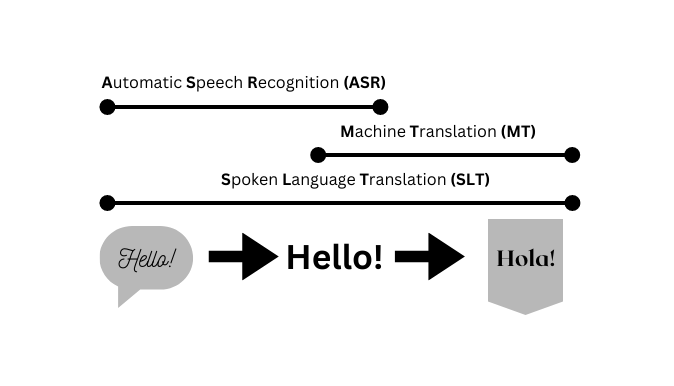The Localization Trends to Watch in 2023

Machines that actually talk, translating beyond the realm of the physical, and performing acrobatics with your budget – as January rolls around once again, the team at Milengo HQ is here to kick off the new year with a collection of some of the most exciting developments and localization trends for 2023.
Localization trend for 2023 #1: Speech-to-speech – The Dream of a Universal Translator

Be it through a microchip implemented under the skin or using a practical device that fits in the palm of your hand, the notion of a communication tool that enables people to have seamless conversations without speaking the same language sounds like something straight out of a Sci-Fi show. Take Star Trek’s universal translator for instance, which unpicks the tangle of languages the crew encounters during their voyages.
But in reality, developing this kind of technology is quite literally easier said than done due to the fact that speaking is effectively writing’s hyperactive younger brother: Instead of delivering clear and concise sentences, we constantly interrupt our train of thought and go off on tangents. We rephrase what we’re saying, we swallow syllables as we’re saying it – and that’s before you consider the slang and regional expressions we throw in – all the while contextualizing everything with our facial expressions and gestures. Given that all these elements are difficult to capture in algorithms, it’s no surprise that there is still a lot of room for improvement in speech-to-speech technology. Products such as the Cheetah CM Translator are already capable of automatically interpreting between two languages, but right now they are more akin to novelty gadgets than genuinely reliable tools.
That could well change in 2023. As a report by industry experts at Slator shows, technology companies, governments, and academia are increasingly looking to join forces to use AI-driven models to translate in real time in the future, making this our first pick for our list of localization trends in 2023. One example of this is Meta (formerly Facebook), which last year made SpeechMatrix – a large-scale multilingual corpus of speech-to-speech translations that can be used as a reference point to develop future translation systems – freely available.
The European Union (EU) is also getting involved in the topic. In 2021, the EU commissioned translation provider RWS to automatically transcribe and translate all parliamentary debates into the 24 official languages used by the institution. In addition, the consortium is also working on developing a concept for wider commercial use, including live translation of audio for web conferences, remote live interpretation platforms, and web technical training. The EU itself was tinkering with its own European Live Translator (ELITR) until 2021 under the banner of “Many languages, one voice.” The goal of the project is to remove the language barrier in communication, especially at large assemblies such as conferences and smaller live discussions such as workshops.

European Live Translator: The process of transcribing and translating the spoken word
Companies have quite a lot to gain from the fact that speech-to-speech promises to soon be even more reliable – the technology could be used in international business communication or to provide multilingual customer service, for instance.
Our pick to read in 2023
The Masakhane project is dedicated to developing AI translation programs for African languages. The continent has been severely underrepresented in natural language processing research to date. Strengthening the preservation and integration of low-visibility and endangered languages as well as improving the support they receive is an important goal within translation research and one that deserves more attention.
Localization trend for 2023 #2: Translation Tools in the Cloud – Hot Air or Heavenly Helpers?

Streaming music on Spotify, doing graphic design work in Photoshop – Software-as-a-Service has long been since been the norm in everyday life. 2023 will see the same happen for translation. It won’t be long before the majority of translation software (translation management system, TMS) is available exclusively as a cloud service, with only the established market leaders such as memoQ or SDL Trados still offering an on-premise client.
There’s no question that the cloud is the future, therefore this is a localization trend worthy of our 2023 list. It allows translation teams to access projects easily through their web browser without having to install the software locally. On top of that, updates are performed automatically and translation management is completely centralized. But as with anything, there are pitfalls to avoid – so make sure you’ve thought about the following aspects before purchasing TMS software:
- Data security: Translation tools in the cloud go to great lengths to protect data. But there is no escaping the simple truth that the more data you accumulate in one location, the greater the risk is that location will be attacked. And a security vulnerability in a cloud-based translation management system potentially affects not just one single company, but everyone using that system. That’s why it’s best if companies host business-critical applications on separate servers that are safely protected behind a robust firewall. This may also be true for your TMS. If you regularly have sensitive texts translated that are vital to the success of your business, then you should thoroughly examine whether a cloud solution meets your security requirements or whether a local installation that sees you retain full control would be the better option. Whatever your decision, don’t make it lightly: A TMS is a long-term investment and it will be expensive and time consuming to replace if you change your mind later.
- Translation features: Most companies prioritize factors such connectors, automation, and efficient translation management when they purchase a TMS. But if your translation volume is very high, then you need to pay special attention to how well the translators can actually work with the software. After all, they’re the ones who spend the most time using the application by far. There is a catch here, however: Cloud solutions often offer reduced translation functionality, so your power users’ productivity may fall by the wayside, which can result in dissatisfied employees or even your translation prices increasing.
Our pick to read in 2023
Is a brand-new translation management system on your wish list for the new year? Then take a look at our blog post in which we compare the most popular solutions on the market.
Localization trend for 2023 #3: Value for Money – Is Translation Getting Too Expensive?

It’s no secret that finding professional translators at affordable prices used to be a lot easier. One reason for this is the high price pressure in the industry. 2023 will see this development come to a head. Inflation is forcing translators to raise their rates, while at the same time the rise of machine translation (MT) is causing translation prices to plummet, sending language service providers into a panic.
In turn, struggling companies are cutting their translation budgets, even though they should be translating more and more content as they continue to expand globally. How can companies achieve the impossible here and get high-quality translations despite having to grapple with tight budgets? Here’s some food for thought:
- Translate less: It might be the case that much of what you have translated actually has little impact. Think obscure blog posts, outdated whitepapers, and subpages of your website that never get any traffic. In the past, companies made themselves visible in foreign markets by simply having as much translated as possible, with quality often playing second fiddle. In today’s experience economy, however, corporate communication needs to stand out from the crowd. With that in mind, take the time to really think about what value your content actually has for people in another language and another country. Don’t have something translated if there is no guarantee it will deliver a tangible return on investment.
- Translate smarter: Not all translations are the same – in fact, there is wide range of different quality levels. Certified machine translation is best for content that is purely for informational purposes. If style and linguistic accuracy are important, then human translators are your first port of call. And to make sure your precision-crafted marketing messages hit their mark, utilizing the creative energy of a transcreation service will do just that.
- Translate with impact: Focus your attention on translations that are the most important to your company’s sales or reputation. Even if your overall translation budget isn’t as large as it used to be, you should still invest in these types of translation. For instance by using qualified translators, commissioning editing services, performing review cycles, optimizing SEO, and more. Online texts in particular only appear at the top of search engine rankings if they are flawless in terms of quality. This is due in part to technologies such as the Multitask Unified Model (MUM) Google introduced in 2021, which the company wants to use to gain a better understanding of the intention of search queries. In the age of this “semantic” search engine, it’s more critical than ever that translated content is also as relevant and as useful as it can possibly be for users.
On that note, this is also where the topic of SEO translation becomes a particular priority and thus ranks on our list with localization trends for 2023. Keywords for each country and language combination need to be carefully researched and the texts may need to be adapted even further during the translation process to fit the respective target culture (by being transcreated, for instance). Marketing teams should never leave this highly specialized work to machine translation services, since Google recognizes automatically generated content and can penalize it with a lower search engine ranking. That’s far too much of a risk to take. Especially if you’ve invested a lot of money in your content and want it to generate traffic, attract new customers, or generate sales. The question of what role the latest generation of conversational AIs such as ChatGPT will play in this context in the future is another matter entirely.
Our pick to listen to in 2023
Are you looking to get a better understanding of how pricing works in the localization industry? Then check out this episode of The Translation Company podcast in which Renato Beninatto from Nimdzi Research and Multilingual Magazine gives his views on the latest industry developments.


